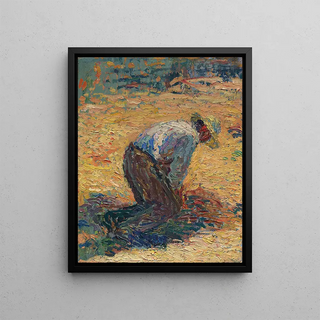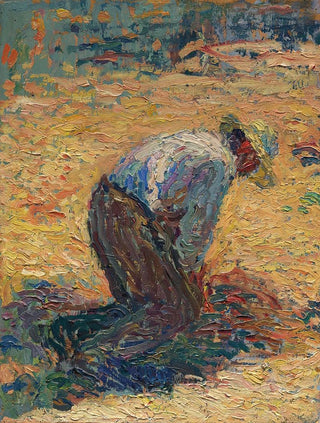Art print | Study for The Harvest - Henri Martin


View from behind

Frame (optional)
Henri Martin’s "Study for The Harvest" awakens the senses and transports the viewer into a world where nature and art meet in harmony. This study, which precedes a major work, reveals the very essence of Martin’s craftsmanship, a master of pointillism. Through this piece, the artist captures not only the light and vibrant colors of the rural landscape but also the soul of passing time—a tribute to the land and its workers. Contemplating this art print, one feels a deep connection with French rural life, evoking memories of past harvests and shared labors.
Style and uniqueness of the work
In "Study for The Harvest," Henri Martin deploys a palette of nuanced colors, where greens, yellows, and browns intertwine with delicate lightness. His use of pointillism, this technique that involves applying touches of juxtaposed color, creates a luminous vibration that brings the landscape to life. Each brushstroke seems to vibrate under the effect of the sun, illuminating the golden wheat fields and the silhouettes of the harvesters. The composition, although seemingly simple, reveals a subtle complexity, where each element is carefully integrated into a perfect balance. The art print invites prolonged contemplation, allowing the viewer to discover hidden details, plays of shadow and light that animate the painting.
The artist and his influence
Henri Martin, an emblematic figure of the post-impressionist movement, knew how to blend tradition and modernity throughout his career. Influenced by masters such as Georges Seurat and Paul Signac, he developed a unique style that is his own. His ability to capture light and color left a lasting impression, making him a pioneer in landscape exploration. Martin was also a passionate advocate of plein air painting, firmly believing that direct experience of nature was essential to artistic creation. His work is not limited to simple representation; it is a celebration of life, a reflection of human emotions in the face of the beauty of the natural world. Through "Study for The Harvest," he reminds us of the importance of the connection between man

Matte finish

View from behind

Frame (optional)
Henri Martin’s "Study for The Harvest" awakens the senses and transports the viewer into a world where nature and art meet in harmony. This study, which precedes a major work, reveals the very essence of Martin’s craftsmanship, a master of pointillism. Through this piece, the artist captures not only the light and vibrant colors of the rural landscape but also the soul of passing time—a tribute to the land and its workers. Contemplating this art print, one feels a deep connection with French rural life, evoking memories of past harvests and shared labors.
Style and uniqueness of the work
In "Study for The Harvest," Henri Martin deploys a palette of nuanced colors, where greens, yellows, and browns intertwine with delicate lightness. His use of pointillism, this technique that involves applying touches of juxtaposed color, creates a luminous vibration that brings the landscape to life. Each brushstroke seems to vibrate under the effect of the sun, illuminating the golden wheat fields and the silhouettes of the harvesters. The composition, although seemingly simple, reveals a subtle complexity, where each element is carefully integrated into a perfect balance. The art print invites prolonged contemplation, allowing the viewer to discover hidden details, plays of shadow and light that animate the painting.
The artist and his influence
Henri Martin, an emblematic figure of the post-impressionist movement, knew how to blend tradition and modernity throughout his career. Influenced by masters such as Georges Seurat and Paul Signac, he developed a unique style that is his own. His ability to capture light and color left a lasting impression, making him a pioneer in landscape exploration. Martin was also a passionate advocate of plein air painting, firmly believing that direct experience of nature was essential to artistic creation. His work is not limited to simple representation; it is a celebration of life, a reflection of human emotions in the face of the beauty of the natural world. Through "Study for The Harvest," he reminds us of the importance of the connection between man






